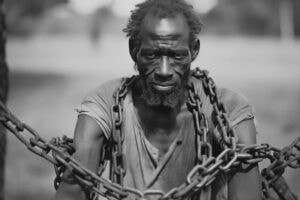The distinction between chattel slavery and ancient slavery runs deeper than just time periods. Chattel slavery treated people as permanent, inheritable property stripping them of all rights and humanity, often based on race.
Ancient systems, while still oppressive, sometimes allowed enslaved individuals to earn freedom or integrate into society. The brutality of chattel slavery left scars that still shape inequality today, making it essential to understand how these systems differed in practice and legacy.
Core Characteristics of Chattel Slavery
Chattel slavery, a brutal and dehumanizing system, treated people as property to be bought, sold, and inherited. Unlike other forms of slavery, it stripped individuals of all rights, reducing them to objects for labor exploitation.
Enslaved people were often separated from families, denied education, and subjected to harsh physical punishment. This system thrived on dehumanization, treating human beings as disposable tools for economic gain.
One key feature was its permanence children born into chattel slavery were automatically enslaved, with no path to freedom.
About 12.5 million Africans were forcibly transported during the transatlantic slave trade, highlighting its scale. The system relied on racial hierarchies, justifying cruelty through false beliefs about superiority.
Chattel slavery differed from ancient systems by its complete denial of personhood. While some historical forms allowed enslaved people certain rights, chattel slavery erased identity entirely. Its legacy continues to impact societies today, reminding us of the importance of justice and human dignity.
Key Features of Ancient Slavery Systems
Ancient slavery systems differed considerably from chattel slavery, as they often allowed enslaved people some degree of legal recognition and social mobility. Unlike chattel slavery, where individuals were treated as property, ancient systems integrated enslaved individuals into households or communities.
Labor obligations varied widely, with some performing domestic tasks while others worked in agriculture or skilled trades. Religious practices also played a role, as enslaved people in some cultures could participate in rituals or even gain freedom through temple service.
In Rome, for example, nearly 40% of the population was enslaved, yet many could earn or buy their freedom. These systems often recognized enslaved individuals as people with limited rights, not mere possessions.
While harsh conditions existed, the possibility of upward mobility distinguished ancient slavery from the rigid, dehumanizing structures of chattel slavery.
Legal Status and Rights of Enslaved Individuals
While enslaved people in many societies faced severe restrictions, their legal status and rights varied considerably depending on time and place. In chattel slavery, individuals were treated as property under law, with no recognized social standing within society. They could be bought, sold, or inherited, and had no legal protections.
Ancient slavery systems, however, sometimes allowed enslaved individuals limited rights, such as the ability to own property or marry. For example, in Rome, some enslaved people could earn wages or gain freedom through manumission.
Their treatment under law often reflected their skills or roles, with educated slaves sometimes holding higher social standing.
Despite these differences, both systems denied basic freedoms, though the degree of oppression varied. Comprehension of these distinctions helps clarify how legal frameworks shaped lives, offering insight into historical injustices while emphasizing the need for compassion in addressing their legacy.
Economic Roles and Social Mobility Differences
The legal status of enslaved people directly shaped their economic roles and chances for social mobility. In chattel slavery, individuals were treated as property, limiting their opportunities to participate freely in labor markets or rise socially.
Ancient slavery, however, often allowed some mobility, with enslaved people sometimes gaining skills or even freedom. Cultural influences also played a role in how these systems functioned.
- Chattel slavery confined people to brutal, lifelong labor with no legal path to freedom.
- Ancient slavery sometimes permitted skilled roles, like teaching or craftsmanship, offering slight upward mobility.
- Labor markets in chattel systems excluded enslaved people, while ancient systems occasionally integrated them.
- Cultural influences determined whether enslaved individuals could earn wages or buy their freedom.
- Social mobility was nearly impossible under chattel slavery but occasionally achievable in ancient contexts.
These differences highlight how systems of oppression varied in their economic and social impacts.
Long-Term Impacts and Historical Consequences
Ancient slavery, while harsh, didn’t create the same racial hierarchies. Chattel slavery’s dehumanizing rules like treating people as property laid groundwork for modern discrimination.
For example, 60% of Black Americans report facing racial bias in housing or jobs, a ripple effect of past injustices.
Both systems disrupted communities, but chattel slavery’s rigid racial caste system entrenched barriers harder to dismantle. Healing requires acknowledging these wounds to build fairer futures. By comprehending history, societies can address its lingering shadows with compassion and action.


